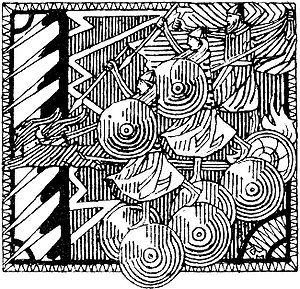
Back Jomsvikings Catalan Jómští vikingové Czech Jomsvikingerne Danish Jomswikinger German Jomsvikings Spanish Jomsviikingid Estonian Jomsviikingit Finnish Jomsvikings French Jomsviking ID Jómsvíkingar Icelandic


The Jomsvikings were a legendary order of Viking mercenaries or conquerors of the 10th and 11th centuries. Though reputed to be staunchly dedicated to the worship of the Old Norse gods, they would allegedly fight for any lord who could pay their substantial fees, even if they may be Christian. The institution of the Jomsvikings would itself foreshadow those of the later religious and chivalric orders of the Middle Ages.[1]
The legend of the Jomsvikings appears in some of the Icelandic sagas from the 12th and 13th centuries. According to the sagas (particularly the Jómsvíkinga saga, King Olaf Tryggvasson’s Saga, and stories found in the Flatey Book), their stronghold of Jomsborg was located on the southern shore of the Baltic Sea, but its exact location has been disputed by modern historians and archeologists. Jomsborg is also thought by some researchers to be identical with Jumne, Julin and Vineta, which are mentioned in both Danish and German records from the Middle Ages.[2][3][4][5] There is no medieval source that mentions a precise location of Jomsborg except for the disputed Gesta Wulinensis ecclesiae pontificum (at 53°51′50″N 14°43′05″E / 53.86389°N 14.71806°E) that was alleged to have been discovered in the autumn of 2019.[6][7][8]
Historians still debate the accuracy of the accounts of the Jomsvikings. Without a conclusively identified location for their headquarters, and because of a lack of primary or contemporary sources specifically mentioning the Jomsvikings or Jomsborg, confirming the tales of their exploits has been difficult. However, there are three contemporary runestones, as well as passages in Old Norse poetry and the lausavísur, that refer to their battles.[9]
- ^ N. F. Blake (1962). "The Sagas of the Jomsvikings" (PDF). Thomas Nelson and Sons. Ltd. Retrieved October 22, 2015.
- ^ Jomsborg (The Polish Review. Vol. 1, No. 1 - Vol. 60, No. 3) by Leon Koczy, Summer 1960
- ^ Jones, Gwyn (2001) A History of the Vikings 127; Otto Kunkel (1941) Jumne, Vineta, Jomsburg, Julin, Wollin.
- ^ Johannes Hoops, Herbert Jankuhn, Heinrich Beck, Reallexikon der germanischen Altertumskunde Band 16, 2nd edition, Walter de Gruyter, 2000, pp.120-121, ISBN 3-11-016782-4
- ^ Władysław Duczko. "Viking-Age Wolin (Wollin) in the Norse Context of the Southern Coast of the Baltic Sea" (PDF). Heimskringla, The Chronicle of The Kings of Norway. Retrieved October 26, 2015.
- ^ Rosborn, Sven (January 8, 2020). "Harald Blåtands släkt". Academia. Archived from the original on June 21, 2020. Retrieved June 21, 2020.
- ^ Sven Rosborn (2021): The Viking King’s Golden Treasure: About the discovery of a lost manuscript, Harald Bluetooth´s grave and the location of the fortress of Jomsborg, Rivengate AB, ISBN 9198678116
- ^ Villads Jensen, Kurt; Jezierski, Wojtek (2022). "Recension av Vikingakungens guldskatt" (PDF). Fornvännen. 2022/1: 76–79.
- ^ For the historiocity of the Jomsvikings and the Saga of the Jomsvikings; for a discussion of different views on the subject, see Jones 127 at n.1. Jones regards the Saga as fictional, but finds arguments that the Jomsvikings themselves could not have existed unconvincing.
© MMXXIII Rich X Search. We shall prevail. All rights reserved. Rich X Search